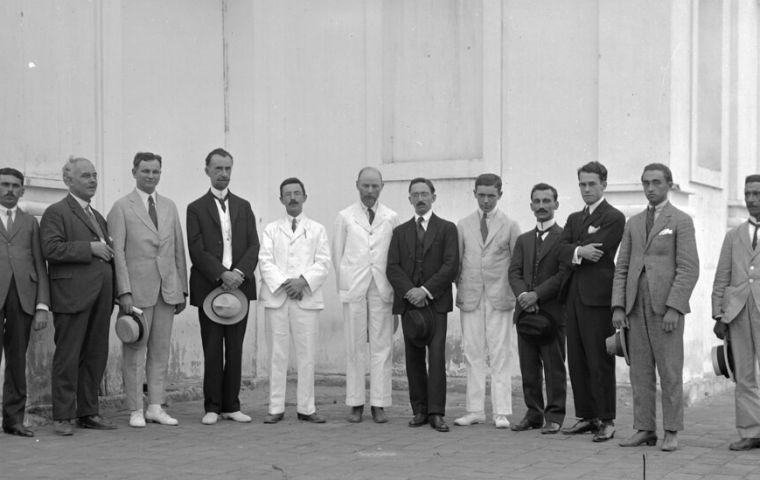MercoPress. South Atlantic News Agency
The centennial anniversary of the Sobral Eclipse, a feat of Brazilian and British astronomers
 With Brazilian colleagues including Henrique Morize, the Director of Brazil’s National Observatory, it was agreed the town of Sobral would be an ideal
With Brazilian colleagues including Henrique Morize, the Director of Brazil’s National Observatory, it was agreed the town of Sobral would be an ideal  Astrological readings could only be taken during an eclipse. Following the end of the First World War, the 1919 eclipse was his best opportunity.
Astrological readings could only be taken during an eclipse. Following the end of the First World War, the 1919 eclipse was his best opportunity. May 29th marked the one hundred year anniversary of the Sobral Eclipse. Six minutes of darkness a century ago put Brazil and the UK at the heart of what was possibly one of the most important scientific discoveries of the 20th century.
Celebrated British astronomer Arthur Eddington had been trying for some years to prove Einstein’s theory of general relatively. Opportunities to do so were rare. Astrological readings could only be taken during an eclipse, when the sun was blotted out and it was possible to take readings of background stars. Following the end of the First World War, the 1919 eclipse was his best opportunity.
After intense collaboration with Brazilian colleagues including Henrique Morize, the Director of Brazil’s National Observatory, Eddington agreed that the small town of Sobral in northern Brazil would be an ideal viewing spot for the eclipse. Two British astronomers travelled from the Royal Observatory in Greenwich to Brazil and set up a small meteorological station in Sobral, working alongside a team of Brazilian astronomers. Transporting their delicate equipment such a distance was a complex challenge. Once in place, I imagine they waited anxiously for 29 May, praying for six minutes of clear skies.
The rest, as they say, is history. In the months following the eclipse, Eddington used photographs and readings taken in Sobral to show the deflection of starlight by the sun’s gravity, which confirmed Einstein’s theory of relativity.
Since then, relativity has been confirmed dozens of times, with much greater accuracy. It has also led to the discovery of other mind-bending wonders, including black holes and gravitational waves. Some have dubbed the period since Sobral as, “the century of gravity”.
In October of last year, the Museum of Astronomy (MAST) in Rio de Janeiro opened a series of events to commemorate the Centenary of the Sobral Eclipse. Dr Richard Dunn, form Royal Observatories Greenwich gave a lecture at a conference marking the beginning of celebrations. The event was an important part of the UK-Brazil Year of Science and Innovation 2018/19, which celebrated the excellence of our bilateral science collaboration. The Director of MAST, Anelise Pacheco, said at the event that, “without co-operation, there is no science”. That is as true today as it was one hundred years ago.
Through the Year of Science we have celebrate the ongoing excellence of our bilateral science co-operation. We held more than 70 events attended by over 8000 scientists, government officials and business leaders across Brazil and the UK. Our scientists shared their research on topics as diverse as climate change, sustainable agriculture, astronomy, biodiversity, infectious diseases and genetics. Through news stories and videos, we reached an audience of over 8.5 million.
One hundred year on, the spirit of UK-Brazil science collaboration that shaped the Sobral discovery is as strong as ever.
Cindy Parker, Regional Manager for Science and Innovation – Latin America




Top Comments
Disclaimer & comment rules-

-

-

Read all commentsGoldie locks, goldie locks, what country will be our friend and help us mask our theft ?
Jun 02nd, 2019 - 09:37 am 0@Patrick Edgar
Jun 02nd, 2019 - 03:24 pm 0Pl. don't be THAT pessimistic! Here is a piece of good news:
https://www.otempo.com.br/image/contentid/policy:1.2189226:1559348617/CHARGE%20O%20TEMPO.JPG?f=3x2&q=0.6&w=620&$p$f$q$w=904c3fd
sorry, don't get it
Jun 02nd, 2019 - 06:05 pm 0Commenting for this story is now closed.
If you have a Facebook account, become a fan and comment on our Facebook Page!